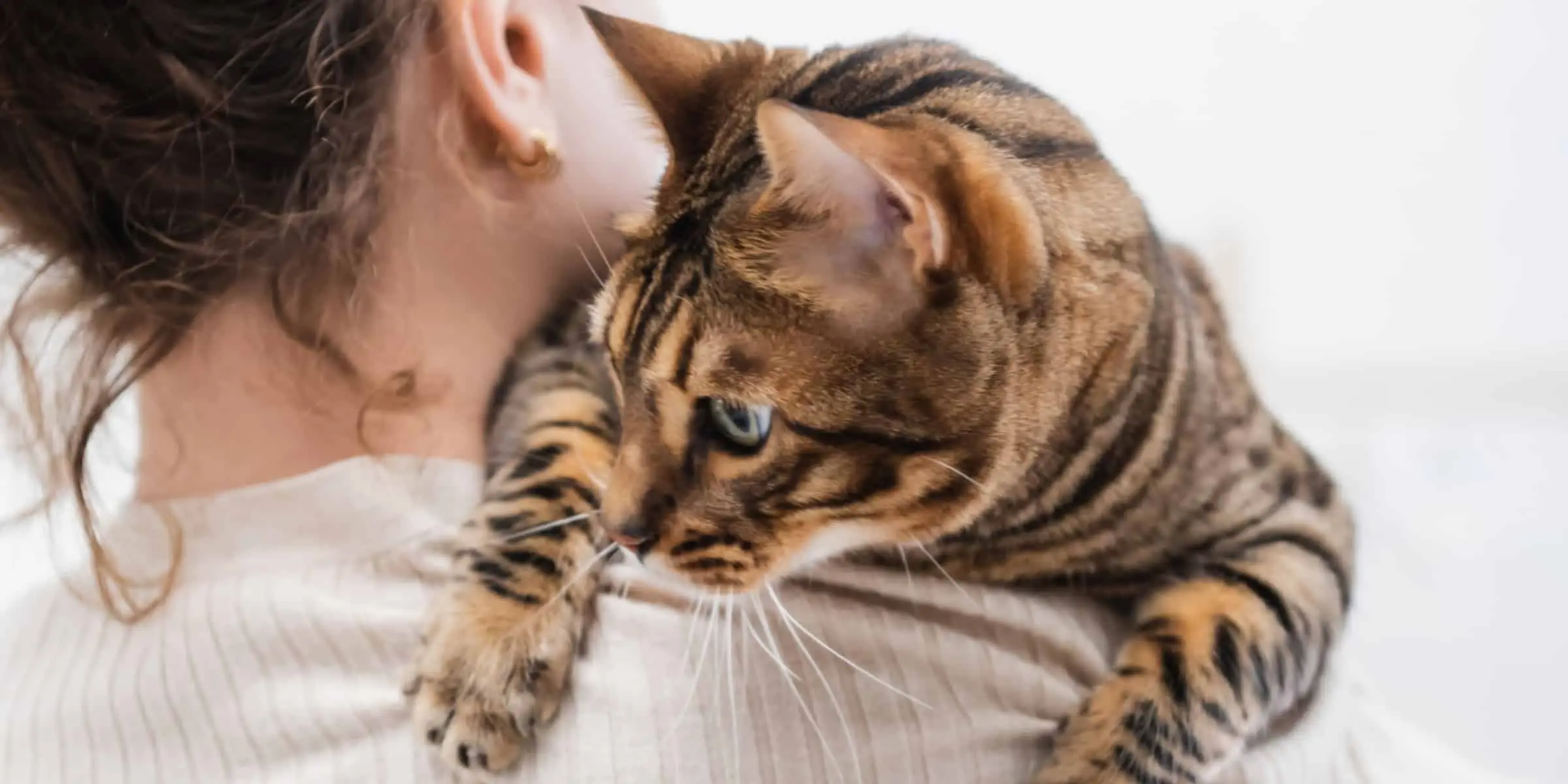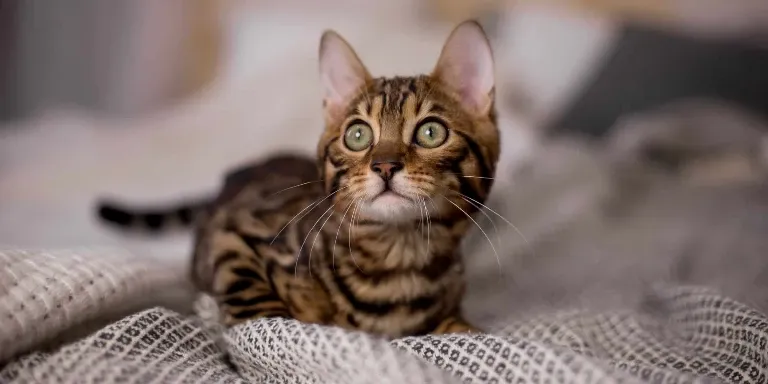The Best Fluffy Pancakes recipe you will fall in love with. Full of tips and tricks to help you make the best pancakes.

If you’re considering adopting a Bengal cat, it’s important to know both the positives and the negatives of sharing your home with this unique breed. While Bengal cats are often praised for their intelligence, athleticism, and striking appearance, there are also some downsides to consider.
The downsides of Bengal cats are that they can be very active and require a lot of attention and exercise. They can also be quite vocal and may demand attention from their owners. Bengals have a strong prey drive and may not get along well with other pets in the household. Some Bengals may also have health issues related to their breeding, such as heart problems or digestive issues.
In this article, we’ll explore the potential drawbacks of owning a Bengal cat, from their high energy levels to their grooming needs.
First and foremost, Bengal cats are known for their incredible energy levels. These cats are not content to simply lounge around all day – they need plenty of physical and mental stimulation to stay happy and healthy. If you’re not prepared to provide your Bengal with ample opportunities for play and exercise, they may become bored and destructive.
Additionally, Bengal cats have a strong prey drive, which means they may be prone to chasing and even attacking small animals or objects. While this instinct can make for an entertaining game of fetch or a fun bonding experience during playtime, it can also lead to problems if your Bengal decides to take their hunting instincts out on your furniture or other household items.
High Energy Levels
Bengal cats are super cute, but their high energy levels can be exhausting for owners who just want a lazy day on the couch. These felines are known for their playful behavior and need for exercise, which can be a challenge for some people.
If you’re not prepared to provide plenty of opportunities for your Bengal cat to burn off energy, you may find yourself dealing with destructive behavior or excessive meowing. One of the downsides of Bengal cats is that they require a lot of physical activity. They love to run, jump, and play, and if they don’t get enough exercise, they can become bored and restless. This can lead to destructive behavior, such as scratching furniture or chewing on cords.
To keep your Bengal cat happy and healthy, be prepared to provide plenty of opportunities for playtime and exercise. This might mean investing in toys that encourage activity or setting up an obstacle course for your cat to navigate. With a little effort, you can keep your Bengal cat entertained and prevent any unwanted behavior.
Prey Drive
One potential issue with owning a Bengal cat is their strong prey drive, which can lead to them chasing after smaller animals in the home or nearby. In fact, according to a study by the American Pet Products Association, around 60% of cat owners report their pets exhibiting hunting behavior towards birds, rodents, or other small creatures.
This can be problematic if you have other pets in the home or live in an area with a lot of wildlife. It’s important to manage their prey drive and train them to redirect their hunting instincts towards appropriate toys and activities.
To manage your Bengal cat’s prey drive, you can try several training techniques. First, provide them with plenty of mental and physical stimulation through interactive toys and playtime. This can help satisfy their natural hunting instincts and redirect their energy towards appropriate outlets.
Second, use positive reinforcement training to teach them commands such as ‘leave it’ or ‘come’ to interrupt any chasing behavior.
Finally, consider providing your Bengal cat with a window perch or outdoor enclosure to allow them to observe wildlife without being able to chase them. With proper management and training, you can help your Bengal cat overcome their prey drive and live in harmony with other pets and wildlife.
Vocalization
Managing vocalization in your feline friend can be a challenge, but it’s important to remember that Bengal cats are known for being vocal. This breed has a unique history that contributes to their talkative nature.
In the wild, they communicate with each other through a variety of vocalizations, such as growls, hisses, and meows. This trait has been passed down to their domesticated counterparts, which means that you may have to deal with a chatty cat.
Training techniques can help manage your Bengal’s vocalization. It’s important to establish boundaries and reward good behavior. If your cat is meowing excessively, try to figure out what they need. They may be hungry, bored, or in need of attention.
By addressing their needs, you may be able to reduce the amount of meowing. Remember, while vocalization can be a downside for some, it’s important to understand that it’s a natural trait for this breed. With patience and training, you can learn to manage your Bengal’s vocalization and enjoy their unique personality.
Health Issues
To maintain your feline friend’s well-being, it’s vital to be aware of potential health issues that may arise.
Bengal cats, like any other breed, have common health issues that may require medical attention. These issues can range from minor ailments such as eye infections and ear mites to more serious conditions such as hip dysplasia and heart disease.
One important thing to note is that Bengal cats have certain genetic predispositions that make them more susceptible to certain ailments. For example, they may be prone to developing a degenerative joint condition called patellar luxation. This occurs when the kneecap slips out of place, causing discomfort and decreased mobility.
Additionally, Bengal cats may be more likely to develop a condition called hypertrophic cardiomyopathy, which is a form of heart disease that causes the heart to become thickened and less efficient at pumping blood.
By being aware of these potential health issues, you can take steps to prevent or manage them, helping to keep your Bengal cat healthy and happy for years to come.
Grooming Needs
Keeping up with a Bengal’s grooming needs is essential for their overall health and happiness. Bengal cats have a thick coat that requires regular brushing to prevent matting and hairballs. Proper grooming is necessary to keep their coat healthy and shiny. Neglecting their grooming needs can lead to a build-up of hairballs in their digestive system, which can cause vomiting and constipation.
To control shedding, it’s important to brush your Bengal regularly. This will help to remove loose hair and prevent it from spreading throughout your home. A clean and well-groomed Bengal will also reduce the risk of allergies and respiratory problems for you and your family.
Overall, keeping up with your Bengal’s grooming needs will not only keep them healthy, but it will also strengthen your bond with them.
Cost
When it comes to the cost of Bengal cats, it’s important to know that they’re generally an expensive breed. This is due to their unique and exotic appearance, which is a result of their wildcat ancestry.
However, it’s not just the initial cost of purchasing a Bengal cat that you need to consider. There can be potential for additional expenses such as veterinary care, specialized food, and toys to keep them entertained.
Expensive Breed
Although Bengal cats are beloved for their unique coat patterns and playful personalities, their status as a luxury breed comes with a hefty price tag. This can be attributed to several factors such as the breeder options available and the ownership expenses that come with taking care of these felines.
Here are some reasons why owning a Bengal cat can be expensive:
- Breeder options: As Bengal cats are a designer breed, it can be difficult to find a reputable breeder who specializes in this particular breed. This can result in higher costs as breeders may charge a premium for their services.
- Vet bills: Bengal cats are known to be prone to certain health issues such as progressive retinal atrophy (PRA) and hypertrophic cardiomyopathy (HCM). As a result, owners of Bengal cats may have to pay higher vet bills to ensure that their feline is healthy and well taken care of.
- Food and supplements: Bengal cats have specific dietary needs and require high-quality food and supplements to maintain their health. This can add up over time and become a significant expense for owners.
- Toys and accessories: Bengal cats are known for their playful personalities and require toys and accessories to keep them entertained. This can also be an added expense for owners who want to provide the best for their feline companions.
Overall, owning a Bengal cat can be a wonderful experience, but it’s important to consider the expenses that come with it. Being prepared for these costs can help ensure that your feline friend receives the best possible care and attention.
Potential for Additional Expenses
Now that you know how expensive Bengal cats can be, it’s important to consider the potential for additional expenses. While they may seem like a worthwhile investment, owning a Bengal cat requires financial preparation and budgeting concerns.
Firstly, Bengal cats require a specific diet to maintain their health and energy. This means purchasing high-quality cat food and supplements, which can add up quickly.
Additionally, like any pet, Bengal cats may require unexpected veterinary care, which can be costly. It’s important to factor in these potential expenses before committing to owning a Bengal cat to ensure that you are financially prepared for the responsibility.
By doing so, you can enjoy the companionship of your Bengal cat without the added stress of financial strain.
Training and Socialization
When it comes to Bengal cats, training and socialization are essential for a happy and well-behaved feline. As an owner, you’ll need to start training your Bengal cat early, as they can be highly energetic and mischievous without proper guidance.
Without early socialization, Bengal cats can develop behavioral issues, such as aggression or fearfulness towards strangers or other animals.
Need for Early Training and Socialization
You’ll want to begin training your Bengal cat early on and socialize them frequently to ensure they grow up to be well-behaved and friendly companions. This is important because Bengals are highly intelligent and active cats.
Without proper training and socialization, they may become destructive or aggressive towards both people and other animals. Consistency is key when it comes to training your Bengal cat. Establish a routine and stick to it to help them understand what behaviors are expected of them.
It’s also important to socialize your Bengal with other animals from a young age. This can help prevent any potential aggression towards other pets in the household or towards unfamiliar animals later on. A well-trained and socialized Bengal can make a wonderful addition to any home, but it requires effort and commitment from the owner to ensure they reach their full potential as a friendly and well-behaved companion.
Potential for Behavioral Issues
If you don’t provide enough mental and physical stimulation for your Bengal, they may develop behavioral issues like destructive behavior or aggression towards humans or other pets. This is why it’s essential to give your Bengal plenty of playtime and interactive toys to keep them mentally stimulated. Otherwise, they may start to feel anxious and bored, which can lead to destructive behavior.
Addressing aggression in Bengals requires patience and consistency. If your Bengal displays aggressive behavior, it’s essential to address the issue as soon as possible. You can start by identifying the cause of the aggression and removing it from the environment. Additionally, you can work on training your Bengal to redirect their attention towards more positive behaviors.
Addressing anxiety in Bengals also requires patience and consistency. You can try providing your Bengal with a safe and quiet space where they can retreat when they feel anxious. Incorporating calming scents and sounds can also help your Bengal feel more relaxed.
Remember, with proper training and care, you can help your Bengal overcome any potential behavioral issues.
Legal Restrictions
Unfortunately, if you’re considering owning a Bengal cat, you may be restricted by legal limitations in certain areas. Some cities and states have regulations in place that prohibit or restrict the ownership of certain exotic animals, including Bengal cats.
These laws are often put in place due to concerns about public safety and the potential for non-native species to disrupt local ecosystems. The legal restrictions on Bengal cats can vary widely depending on your location.
Some areas may require specific permits or licenses to own a Bengal cat, while others may ban their ownership entirely. It’s important to research the laws in your area and ensure that you’re in compliance before bringing a Bengal cat into your home.
While these restrictions can be frustrating, they’re in place to protect both the public and the animals themselves.
Are the High Costs of Bengal Cats Related to Their Downsides?
The high costs of Bengal cats are mainly due to their unique and appealing traits, such as their distinctive coat and playful nature. However, some downsides, such as their high energy levels and potential for behavioral issues if not properly stimulated, can also contribute to why Bengal cats expensive.
Conclusion
Congratulations! You’ve just learned about the downsides of owning a Bengal cat. Although these beautiful felines are known for their stunning appearance and affectionate personalities, it’s important to consider the potential challenges that come along with them.
From their high energy levels and prey drive to their vocalization and grooming needs, Bengal cats require a lot of attention and care. Additionally, their health issues and legal restrictions can add extra stress and expense to their ownership.
However, don’t let these downsides discourage you from experiencing the joys of owning a Bengal cat. With proper training, socialization, and love, these cats can make wonderful companions for any cat lover.
In conclusion, owning a Bengal cat is both a rewarding and challenging experience. It’s important to understand the potential downsides before making the commitment to bring one into your home. By being aware of their unique needs and challenges, you can be better prepared to provide them with the care and attention they deserve. Remember, with patience, determination, and a little bit of love, you can create a wonderful life with your Bengal cat.








